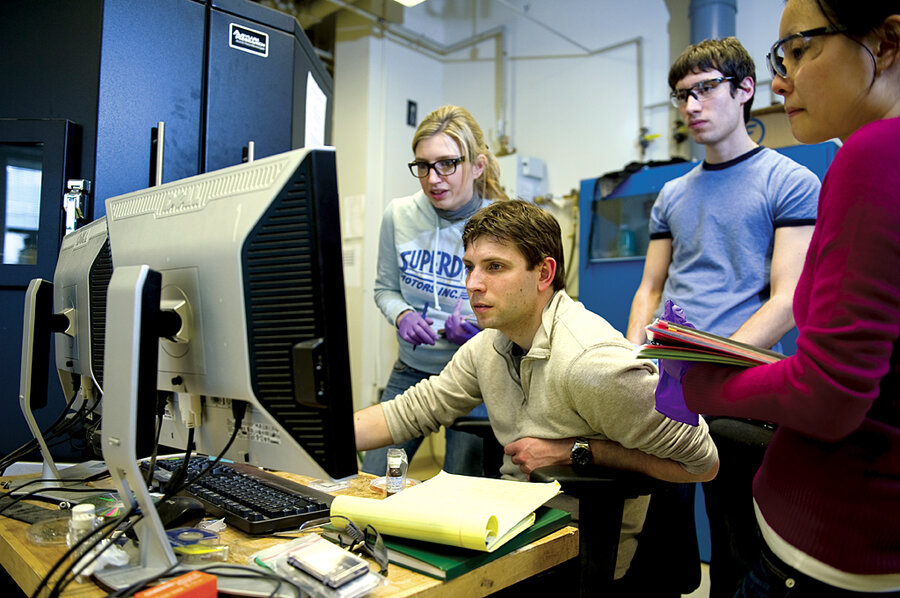US losing its technological edge? No!
Loading...
Amid some $40 billion in budget cuts in April, Congress decided to preserve a favorite – education programs for science, technology, engineering, and math.
"STEM" programs, as they're called, have rare bipartisan support in a Congress worried about the United States' economic competitiveness. Business groups are pushing for more funding. President Obama has called the crisis "our generation's Sputnik moment."
But what if the crisis isn't real?
Political rhetoric aside, there's no lack of workers to fill technical jobs. And the pipeline of US math and science students to fill future positions has not deteriorated in terms of international competitiveness in the past 15 years.
"Every time we look at these shortage claims, we can't find them," says Hal Salzman, a public policy expert at Rutgers University in New Brunswick, N.J.
Nobody argues that the US couldn't do better in improving science and math education and technological competitiveness. But if the justification for pumping up STEM education is an economic one, alarmist warnings could take money away from equally deserving programs.
"They're asking the government to direct a huge number of resources to increase the supply for something that's not in great demand," says Mr. Salzman. "Does that come at the expense of dealing with real problems?"
That the US might be losing its technological edge has been a recurring theme since at least the Soviet launch of Sputnik 1 in 1957, which galvanized US science education. Worries reemerged in the 1980s as Japan made inroads into traditional US industries, such as automobiles. It is again a lively topic now as China challenges US primacy.
"The number of jobs out there that require a strong foundation in STEM has grown dramatically," says Claus von Zastrow, chief operating officer of Change the Equation, a STEM education advocacy group. "The fact is that if students aren't able to keep pace with these demands, we can really question whether we'll remain at the forefront of innovation."
Change the Equation, a group of more than 100 chief executive officers that formed last year to focus effective philanthropy and change standardized testing of STEM subjects at the state level, is driven by worries that the US economy and national security could become compromised if education falls behind. Likewise, a 2010 revision of a 2005 National Academies Press publication warns that the US "has increasingly placed shackles on [innovative] prowess such that, if not relieved, the nation's ability to provide financially and personally rewarding jobs for its own citizens can be expected to decline at an accelerating pace." The America COMPETES Act was signed into law in 2007 following the initial study, though it has yet to be funded.
"This is one of those storms that builds up very slowly," says Norman Augustine, retired CEO of Lockheed Martin Corp. and chairman of the committee that wrote the original study. "It's not a lightning storm or earthquake. It's more like a hurricane that gradually comes upon you."
But policymakers may want to take a closer look at the numbers before they take more action. Although the US has dropped slightly in its share of the world's technical publications and cited work, "on the whole the evidence did not support that we had a shortage of STEM workers in the economy," says James Hosek, a researcher at the RAND Corp. in Santa Monica, Calif., and coauthor with RAND's Titus Galama of a 2008 study on the issue.
In fact, data show that the US accounts for 40 percent of the entire world's research and development spending, and it increased that spending more than any other region between 1993 and 2003. Between 1983 and 2007, the percentage of the workforce in science and engineering occupations grew from 2.6 percent to 4.3 percent. The number of graduates in the STEM fields exceeds the number of people who end up working in those fields.
Those are healthy signs for the US, since there does seem to be a correlation between the size of a country's scientific workforce and its economic growth, according to a 2000 study by three Stanford University and University of California, Irvine, professors.
What's not so clear is whether US student performance is that relevant. "If you put aside the statistics and look what's going on, it's not clear to me that you can predict economic growth on how kids are doing on international standardized tests," says Francisco Ramirez of Stanford, one of the coauthors of the 2000 study.
In any case, American students have mostly improved their scores in the three tests since the 1995 TIMMS (Trends in International Mathematics and Science Study). And their rankings – typically low or average – among students in about 50 countries has not changed
For Mr. Hosek, the most important investments for children are in high-quality education, in general, and health. STEM programs can have an emotional appeal, but "we do want some evidence, some assurance, that these policies really are effective and not just appealing," he says.





